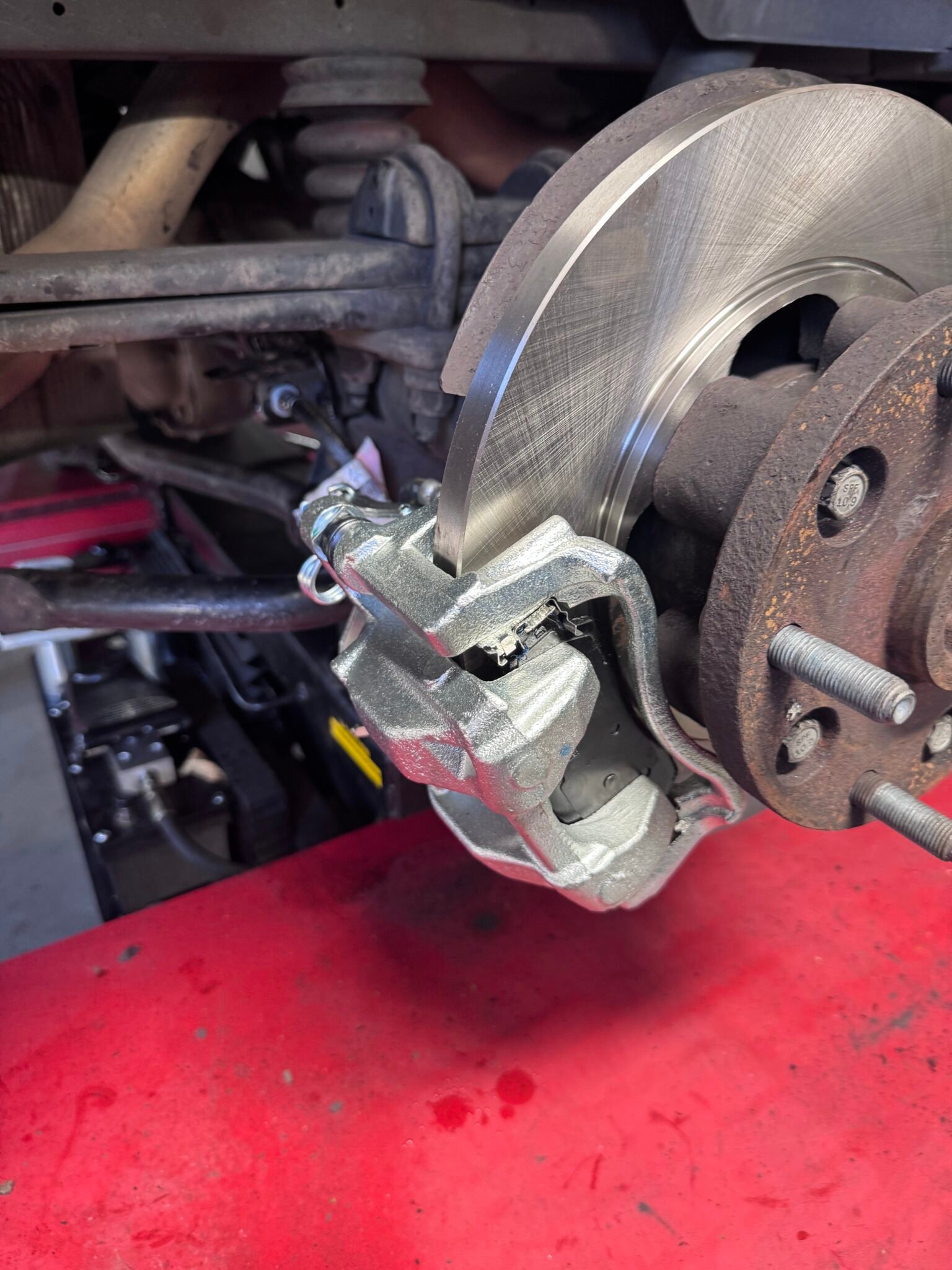
The brake system of your motor vehicle not only ensures its optimal performance but also plays a big role in your safety on the road. Thus, keeping your motor vehicle brake system in good condition is very important for your safety and the long life of your motor vehicle.
Here is how you can identify a faulty motor vehicle brake system:
How Does Your Motor Vehicle Brake System Work?
Your motor vehicle makes unusual sounds during the drive.
You see yellow puddles of brake fluid under your motor vehicle.
You experience less resistance in the pedal while braking.
Your motor vehicle doesn’t stop immediately after braking.
You feel vibration to one side while braking.
Your motor vehicle pulls to one side during braking.
You see yellow puddles of brake fluid under your motor vehicle.
You experience less resistance in the pedal while braking.
Your motor vehicle doesn’t stop immediately after braking.
You feel vibration to one side while braking.
Your motor vehicle pulls to one side during braking.
To keep your motor vehicle brakes in good condition, it is very necessary to understand how your motor vehicle brake system works.
The brake system of the present day motor vehicles is the result of over hundred years of automotive innovation. The basis stopping functioning of the traditional motor vehicles has now transformed into the reliable and eff ective piece of speed variation equipment.
While the brake systems of motor vehicles vary by their make and model, the basic components of the brake system of motorvehicles consists of the disc brakes in the front, and either disc brakes or drum brakes in the rear. The brakes systems of all the wheels of your motor vehicle are connected by a network of tubes and hoses and a master cylinder supplies them the vital brake fluid or hydraulic fluid through this network of tubes and hoses. Before learning how all these components of the present day motor vehicle brake system ensure the timely stoppage of your motor vehicle, it is very important to learn about the functions of these present day motor vehicle brake system components, which can broadly be divided into two categories.
1.Hydraulic System of the Motor Vehicle Brake System
2.Friction Materials of the Motor Vehicle Brake System
While the brake systems of motor vehicles vary by their make and model, the basic components of the brake system of motorvehicles consists of the disc brakes in the front, and either disc brakes or drum brakes in the rear. The brakes systems of all the wheels of your motor vehicle are connected by a network of tubes and hoses and a master cylinder supplies them the vital brake fluid or hydraulic fluid through this network of tubes and hoses. Before learning how all these components of the present day motor vehicle brake system ensure the timely stoppage of your motor vehicle, it is very important to learn about the functions of these present day motor vehicle brake system components, which can broadly be divided into two categories.
1.Hydraulic System of the Motor Vehicle Brake System
2.Friction Materials of the Motor Vehicle Brake System
How the Hydraulic System of Motor Vehicle Brake System Works?
The hydraulic system of the present day motor vehicle brake system consists of the master cylinder, the brake lines and hoses, and the wheel cylinders and calipers. The master cylinder of the present day motor vehicle brake system works as the pressure converter. When you put your foot on the brake pedal, the master cylinder converts the physical pressure exerted on the brake pedal into the hydraulic pressure and this hydraulic pressure propels the brake fluid to the brake system of each wheel through a network of steel-braided brake lines and high pressure, shock and road-resistant brake hoses.
The wheel cylinders of the present day motor vehicle brake system consist of cylinders surrounded by two rubber-sealed pistons connecting it to the brake shoe. When you put your foot on the brake pedal, the exerted physical pressure forces out these pistons and pushes the brake shoes into the drums. The calipers of the present day motor vehicle brake system squeeze the brake pads on to the rotor to stop your motor motor vehicle.
These components also apply pressure to the friction materialsof the brake system.
The wheel cylinders of the present day motor vehicle brake system consist of cylinders surrounded by two rubber-sealed pistons connecting it to the brake shoe. When you put your foot on the brake pedal, the exerted physical pressure forces out these pistons and pushes the brake shoes into the drums. The calipers of the present day motor vehicle brake system squeeze the brake pads on to the rotor to stop your motor motor vehicle.
These components also apply pressure to the friction materialsof the brake system.
How the Friction Materials of the Motor Vehicle Brake System Work?
The disc brake system of the present day motor vehicles uses the hydraulic fluid released by the master cylinder) to exert pressure into a caliper to press it against a piston so that it can squeeze the two brake pads against the rotor of the motor vehicle to stop it immediately. The brake shoes of the present day motor vehicle consists of a steel shoe with friction material bonded to it.
How the Hydraulics and Friction Materials of the Present Day Motor Vehicle Brake System Ensures Immediate Stoppage at High Speed?
The moment you put your foot on the brake pedal of your motor vehicle, the physical pressure exerted on it triggers the release of the brake fluid into a network of steel-braided brake lines and hoses connected to the braking system of each wheel of the motor vehicle.
This happens due to the fact that the moment you press the brake pedal, you are actually pushing against a plunger in the master cylinder which triggers release of the brake fluids to the brake system. Now, since the brake fluid can’t be compressed, it travels through the network of steel-braided brake lines and hoses connected to the braking system of each wheel of the motor vehicle with the same motion and pressure it initially began with . That’s how, the brake system of the present day motor vehicles ensures their complete stoppage at high speed.
This happens due to the fact that the moment you press the brake pedal, you are actually pushing against a plunger in the master cylinder which triggers release of the brake fluids to the brake system. Now, since the brake fluid can’t be compressed, it travels through the network of steel-braided brake lines and hoses connected to the braking system of each wheel of the motor vehicle with the same motion and pressure it initially began with . That’s how, the brake system of the present day motor vehicles ensures their complete stoppage at high speed.
What Causes the Malfunctioning of the Present Day Motor Vehicle Brake System?
The present day motor vehicle brake system often malfunction when the air is introduced into the brake fluid. As the air can compress, it creates sponginess in the pedal, which aff ects this consistency and results in malfunctioning of the motor vehicle brake system. The best way to improve the functioning of the present day motor vehicle brake system is removing the bleeder screws located at each wheel cylinder to make the brake system bleed out the unwanted air.
How to Keep Your Motor Vehicle Brake System in Good Condition?
To keep your motor vehicle brake system in good condition, you must ensure regular preventive service of your motor vehicle brake system by the expert motor vehicle brake service technicians. You can visit the offi cial website of Bhagat Automotive to schedule your motor vehicle brake system inspection, repairs and replacement service.
The certified motor vehicle brake system repairs technicians at Bhagat Automotive are proficient repairing the disc brakes (including rotors, pads, calipers, hardware), brake dumbs, brake shoes, wheel cylinders, return springs, hydraulic systems (including the master cylinder), brake hoses, power boosters, parking brake cables etc. of the present day motor vehicle brake system. The other motor vehicle brake system service off ered by the expert brake repair technicians of Bhagat Automotive include physical inspection of brake friction and hydraulic system, resurfacing or rotors and/or drums, brake pads and brake shoes replacement, physical inspection and repack of wheel bearing, and brake fluid flushing, if required.
The certified motor vehicle brake system repairs technicians at Bhagat Automotive are proficient repairing the disc brakes (including rotors, pads, calipers, hardware), brake dumbs, brake shoes, wheel cylinders, return springs, hydraulic systems (including the master cylinder), brake hoses, power boosters, parking brake cables etc. of the present day motor vehicle brake system. The other motor vehicle brake system service off ered by the expert brake repair technicians of Bhagat Automotive include physical inspection of brake friction and hydraulic system, resurfacing or rotors and/or drums, brake pads and brake shoes replacement, physical inspection and repack of wheel bearing, and brake fluid flushing, if required.


